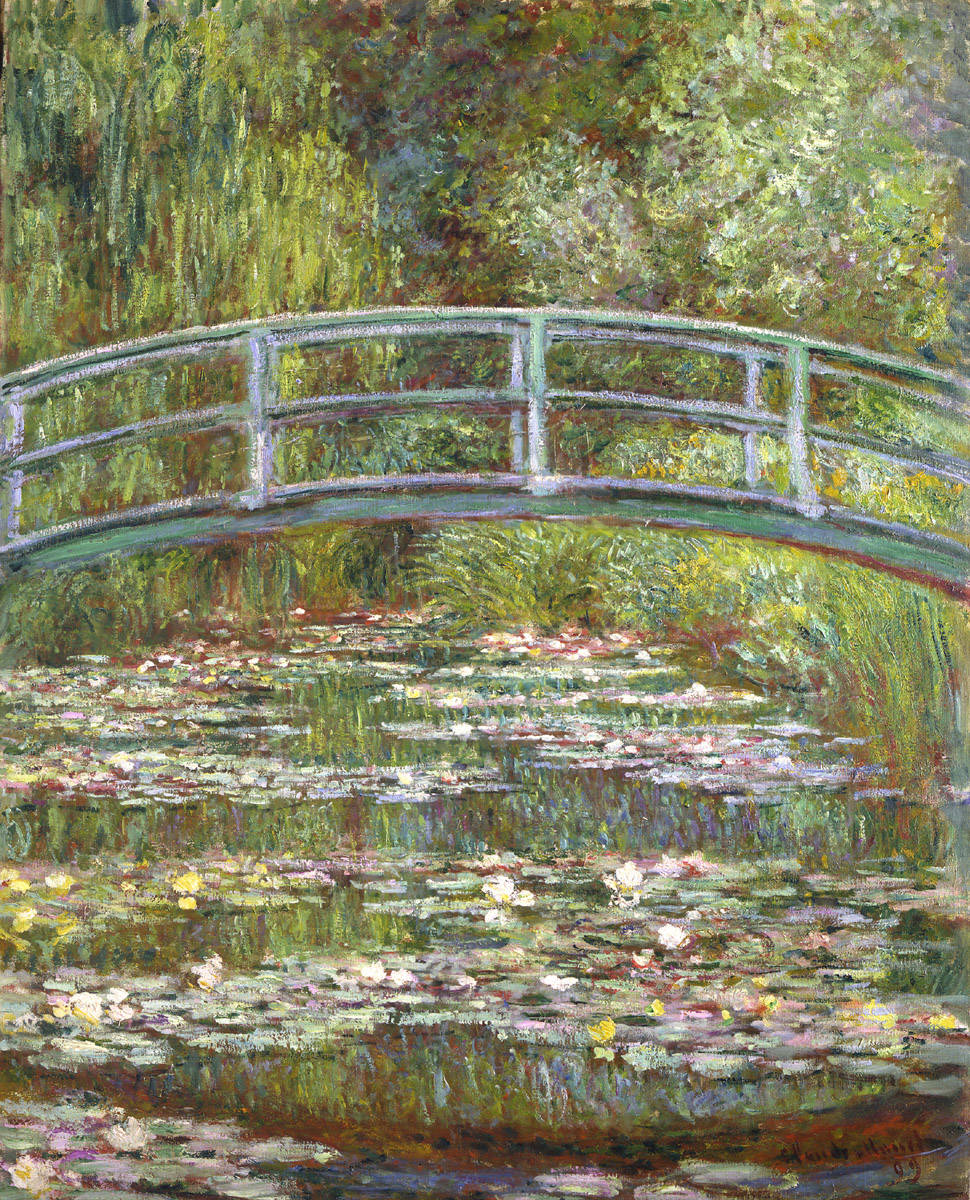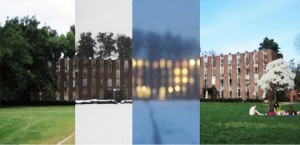Archaeosoup Productions presents a Youtube video about how we think about who was hygienic back in the iron age. Many seem to attribute our current values of cleanliness and beauty to the ancient Romans, but the Northern Europeans had their own rituals of hygiene. It is worth taking a look at Archaeosoup Productions’ other videos–they have lots of videos about archaeology and various channels that approach the discipline from different angles. One channel explains aspects of the discipline, another answers viewers’ questions, and this video was from a channel called “Hidden Histories.”
Archaeology of the Internet
![]() The website of an advertising company called Story Worldwide describes an interesting project called “Digital Archaeology.” This was an exhibition of websites that “many consider to be the most significant sites of their time, each pushing the boundaries of how we play, interact and are entranced by technology.” Each website was shown on the original computers and browsers of its time, a neat way to transport the viewer back in time to the early days of the internet when these “artifacts” were first made and used. One of the main goals of the project was to encourage the archiving of important early websites as cultural resources, just like ancient artifacts are considered cultural resources to be preserved for future knowledge today. This is a neat project and it makes you think about what kinds of questions future generations of archaeologists will be asking about our time, and what kinds of materials, digital and physical, they will consider important finds.
The website of an advertising company called Story Worldwide describes an interesting project called “Digital Archaeology.” This was an exhibition of websites that “many consider to be the most significant sites of their time, each pushing the boundaries of how we play, interact and are entranced by technology.” Each website was shown on the original computers and browsers of its time, a neat way to transport the viewer back in time to the early days of the internet when these “artifacts” were first made and used. One of the main goals of the project was to encourage the archiving of important early websites as cultural resources, just like ancient artifacts are considered cultural resources to be preserved for future knowledge today. This is a neat project and it makes you think about what kinds of questions future generations of archaeologists will be asking about our time, and what kinds of materials, digital and physical, they will consider important finds.
Archaeological Evidence of Amelia Earhart as a Castaway
Executive director of The International Group for Historic Aircraft Recovery, Ric Gillespie, describes the latest evidence supporting a theory that Amelia Earhart and her navigator, Fred Noonan, might have landed in 1937 on an island called Nikumaroro and survived as castaways for weeks or even months. Gellespie’s slideshow explains all of the fascinating finds from the island, such as cosmetics and a pulverized pocket knife, discusses documentary and even eyewitness evidence that supports the theory, and describes the daunting challenges that a castaway was would have faced on the island, including crabs that would eat you alive and the acquisition of drinkable water. I highly recommend watching this if you have any interest in the mystery of Amelia Earhart or historical archaeology.
Reconstructions & The Power of Technology
In our discussion of archaeological reconstructions, we found that the major methods for site presentation include the stabilization and preservation of ruins, ghost buildings, and full-scale reconstructions. Each have different elements of site disturbance associated with them.
A method of reconstruction we didn’t discuss was virtual reconstruction. In virtual worlds like Second Life, it is possible to reconstruct a site to full detail. One of the possibilities opened up by virtual reconstruction is the reproduction of large sites where tangible reconstruction would be an impossibility, such as the city of Lisbon.
As technology progresses and archaeologists become more tech-savvy, it may be possible to eliminate some of the drawbacks to real-life and virtual reconstruction by combining the two- holograms can be projected at real sites with minimal invasion of the surviving foundations, and tourists will be able to walk through the site without the mediation of a screen.
The Hero’s Excavation: The Mythopoetic Archaeologist in Popular Culture
After reading my colleagues’ discussions of Indiana Jones and the Titanic, I thought it might be appropriate to write about the romance of archaeology in popular culture, particularly in regard to notions of heroism:
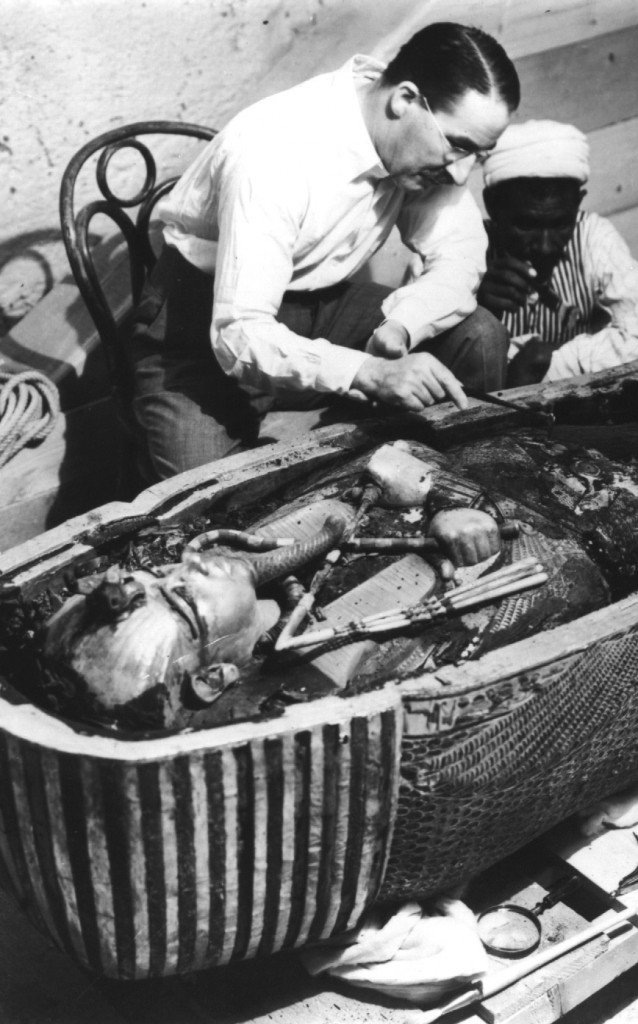
Howard Carter inspecting King Tut with an unnamed colleague (Source: Teresa Wilde's Demon of the Week)
Like Indiana Jones, many of the most famous archaeological sites are characterized by a monolithic researcher, converting the archaeologist as a singular researcher into an archetype, a singularity. Tutankhamun’s tomb had Howard Carter; Olduvai Gorge had the Leakys; and Egyptology (until the Mubarak debacle, at least) had Zahi Hawass. The archaeologist as archetype is considered the supreme authority in their area of expertise, which permits them the authorship to unveil treasures and past events (another equally valuable of capital, one might argue) as yet another flourish to their legacy. We have already discussed the rhetoric of “discovery”, “seeking out”, “treasure-hunting”, and “revealing”, and I think it is telling that a single figure is often set at the head of these efforts. Recalling classical anthropology’s embedded militancy metaphors, the archaeologist becomes analogous to a war hero, or even a crusader, preserving and protecting and elevating a sacred property so that it does not fall victim to the ravages (or “savages”) of time.
We have discussed the difficulty of simply supplanting these dominant metaphors with our own “more appropriate” tropes; what sort of altered hero narrative do you think would be more befitting community archaeology (a priest, spreading a doctrine for the benefit of their parish to inspire them to good works?), or public archaeology (a wandering bard, like Homer or Johnny Appleseed?), or any other archaeological variants we have studied? Do we need a hero narrative at all– or rather, why do you think it is there in the first place?
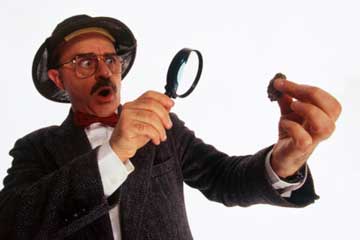
Alternatively, if you search "archaeologist" in Google Images, the results are-- more often than not-- a far cry from "heroic". (Source: How Stuff Works)
Image sources:
Howard Carter and an unnamed colleague. Teresa Wilde’s Demon of the Week Blog.
Alternatively, if you search… How Stuff Works.
Indiana Jones and the Archaeological Dig
While we’re on the topic of the use of archaeology in films, the ever-popular Indiana Jones series of movies deserves a mention.
I grew up on these movies, and for years we had a whip in our costume box so my brother could dress up as Indiana, who was the ultimate action hero with a mild-mannered professor for an alter-ego. When archaeologists want to discuss popular misconceptions of what archaeologists do, they tend to point towards Indiana Jones, who we first meet in The Raiders of the Lost Ark as he steals a gold treasure from a perfectly preserved ancient temple, dodging booby traps and the incensed natives. His catchphrase, “That belongs in a museum!” does little to counteract the fact that Indiana Jones is more looter than archaeologist.
How much does Indiana’s character affect what people think of archaeologists? When I watched the movies as a child, I already had such a strong association between archaeology and digging that the only scene in the movie in which I felt archaeology was being performed was the Nazi-funded excavation in Cairo. My impression of archaology was no more correct, then- (had you asked me for an example of an archaeological dig in a movie I night have pointed you to Jurassic Park) but it was not quite so shaped by the movies as concerned archaeologists might fear.
However, Indiana Jones is a powerful icon, and public archaeology tends to evoke him whenever possible in order to generate interest.
These two exhibits, one by the National Science Foundation and the other by National Geographic, both compare modern archaeologists to the famous hero, emphasizing discovery and unlocking secrets in particular. Visit them, and you’ll notice that one adopts a more critical stance than the other, but both focus on similarities over differences. Is this comparison harmful to public archaeology?
More on the Titanic: Is James Cameron an Archaeologist?
I’m so glad that Anne posted about the Titanic because I’ve been meaning to write a little something about it ever since I saw Titanic 3D a couple weekends ago.
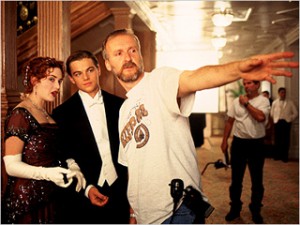 Now, I don’t mean to claim that James Cameron is an archaeologist HOWEVER I am really interested in some archaeological ideas Cameron presents in his film Titanic.
Now, I don’t mean to claim that James Cameron is an archaeologist HOWEVER I am really interested in some archaeological ideas Cameron presents in his film Titanic.
I first saw the film when I was in elementary school and all I really remember is thinking how sad it was that Jack died in the end and how crazy the old woman was for throwing the necklace back into the sea. Watching it now, especially after having learned a bit more about archaeology this semester, I have a slightly different mindset.
Both in Avatar and in Titanic Cameron does a phenomenal job of portraying the treasure-hunting greedy American as insensitive and as one who dehumanizes the artifacts and land that are in his way (the RDA corporation and Brock Lovett respectively). In class, we’ve talked a lot about this perception of archaeologists. This view, commonly shared among some Native American groups, who have traditionally viewed archaeologists as grave-robbing treasure-hunters, has hindered archaeological projects and has led to a mistrust of archaeologists by some Native Americans. When the treasure-hunters in the film explain how the ship sunk to the modern day elderly Rose, they are pretty insensitive:
Lewis Bodine: [narrating an animated sequence of the Titanic’s sinking on a TV monitor] Okay here we go. She hits the berg on the starboard side, right? She kind of bumps along punching holes like Morse code, dit dit dit, along the side, below the water line. Then the forward compartments start to flood. Now as the water level rises, it spills over the watertight bulkheads, which unfortunately don’t go any higher than E deck. So now as the bow goes down, the stern rises up. Slow at first, then faster and faster until finally she’s got her whole ass sticking up in the air – And that’s a big ass, we’re talking 20-30,000 tons. Okay? And the hull’s not designed to deal with that pressure, so what happens? “KRRRRRRKKK!” She splits. Right down to the keel. And the stern falls back level. Then as the bow sinks it pulls the stern vertical and then finally detaches. Now the stern section just kind of bobs there like a cork for a couple of minutes, floods and finally goes under about 2:20am two hours and forty minutes after the collision. The bow section planes away, landing about half a mile away going about 20-30 knots when it hits the ocean floor. “BOOM, PLCCCCCGGG!”… Pretty cool, huh?
Old Rose: Thank you for that fine forensic analysis, Mr. Bodine. Of course, the experience of it was… somewhat different. (reference here)
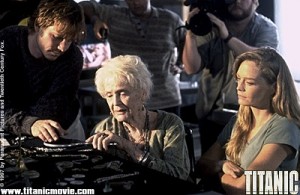 Rose then proceeds to explain her personal experience on the Titanic. This oral history serves to humanize the search bringing life back to the artifacts the treasure hunters have collected including a hand mirror and a butterfly hair accessory. This is important in archaeology. The objects on their own and out of context (in the film they were presented on a table) seem to just be old objects from a sunken ship. However when brought to life by a personal experience or story and put into context of use and purpose, a viewer can have a totally different and emotional response to seeing and interacting with that object.
Rose then proceeds to explain her personal experience on the Titanic. This oral history serves to humanize the search bringing life back to the artifacts the treasure hunters have collected including a hand mirror and a butterfly hair accessory. This is important in archaeology. The objects on their own and out of context (in the film they were presented on a table) seem to just be old objects from a sunken ship. However when brought to life by a personal experience or story and put into context of use and purpose, a viewer can have a totally different and emotional response to seeing and interacting with that object.
After Rose shared her story about surviving the shipwreck, the main treasure hunter, Lovett, says to Rose’s granddaughter, “Three years, I’ve thought of nothing except Titanic; but I never got it… I never let it in.” (ref)
I think what he meant here is during these past few years he has been meticulously researching the event and searching for treasure on site only really viewing the Titanic in an objective scientific sense. He viewed it, in a way, as intangible event instead of viewing the ship itself as an artifact marking a serious tragedy. The ship had its own life, significance, and culture and was much more complex than he may have completely realized. The site itself is essentially a mass grave for over 1,000 people. To someone removed from the event, that number may just seem like a statistic. However when presented with the stories of the people it personally affected, the number may illicit a much more emotional response and deeper understanding of what the sinking of the Titanic really meant.
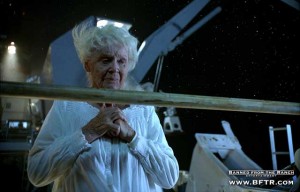
And now I think I understand why Rose threw the necklace into the ocean: because it belonged with the ship and the rest of the artifacts from the site. It belonged in the earth under the ocean, not with treasure-hunters, not in a museum, not even with her.
This is a concept that I had been struggling to completely grasp. I guess growing up the way I did, attending public school in northeastern USA up until Vassar, I kind of felt like it was the archaeologist’s right to dig up essentially anything for the sake of knowledge and preservation. And I’m not trying to say that I didn’t have a good public school education because I really did, it’s just that archaeology wasn’t really the main topic of discussion in any of my classes. It wasn’t until I took this course that I realized that archaeology and archaeological excavations are not as simple as finding treasure and unearthing mysteries in our history, as I had always assumed. In the case of some Native American communities, it is natural and right for humans and objects to return to the earth when the time has come for them to do so. So it’s hard, I think, to really determine if archaeologists have the right to dig up sites for the greater good of knowledge or if they should leave the site be. Collaboration between archaeologists and the community that the archaeologists’ research affects is, I think, a step in the right direction. Constantly reminding the archaeologist of the human aspect of their research and how that affects that modern-day community can enrich the research project and ultimately potentially have a greater and more significant impact.
Archaeology of the Titanic
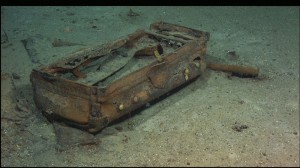 In lieu of the 100th anniversary of the sinking of the Titanic, this article, from Archaeology Magazine, details the process of the exploration of the Titanic as it has developed with the field of underwater archaeology and advances in deep-sea technology. I found it extremely interesting that it was not until very recently the underwater wreckage has been considered an archaeological site. In the most recent excavation in 2010, new underwater robotic vehicles were able to take 3-D photos of all areas of the ship, creating detailed site maps and allowing archaeologists to literally “walk on the decks of the ship.” Archaeologists have now begun the task of identifying the context of various artifacts, features. I was also intrigued by the ethical and legal issues that excavators have faced in the 25 years since the ship was discovered, which tie in to some of the same issues we have discussed with repatriation, leaving sacred artifacts untouched, why and how artifacts are removed from the ground (or the sea!) and what happens to them next.
In lieu of the 100th anniversary of the sinking of the Titanic, this article, from Archaeology Magazine, details the process of the exploration of the Titanic as it has developed with the field of underwater archaeology and advances in deep-sea technology. I found it extremely interesting that it was not until very recently the underwater wreckage has been considered an archaeological site. In the most recent excavation in 2010, new underwater robotic vehicles were able to take 3-D photos of all areas of the ship, creating detailed site maps and allowing archaeologists to literally “walk on the decks of the ship.” Archaeologists have now begun the task of identifying the context of various artifacts, features. I was also intrigued by the ethical and legal issues that excavators have faced in the 25 years since the ship was discovered, which tie in to some of the same issues we have discussed with repatriation, leaving sacred artifacts untouched, why and how artifacts are removed from the ground (or the sea!) and what happens to them next.
Monet’s Gardens in Giverny
In class we have been discussing the many different ways in which an archaeological site can be displayed as an exhibit. Although it may not exactly be an archaeological site, Monet’s Gardens in Giverny is a great example of how some exhibits, like the St. Mary’s exhibit in Maryland, take the approach of recreating the site as it was in the past.
Monet’s gardens and house in Giverny was the home of the French impressionist painter, Claude Monet and his family. The gardens were inspiration for many of Monet’s famous works including Bridge over a Pond of Water Lilies (1899). Many years after Monet had passed and the property remained neglected by the family, it was finally in 1977 that Gérald van der Kemp was appointed curator at Giverny by the Academie des Beaux-Arts. After about 10 years of restoration the property was well suited for visitors. The idea behind the restoration process was to make the property look very similar to its original form.
There are currently many gardeners staffed to keep up the appearance of the garden throughout the year. When I visited, everything was green because it was the summertime, so the gardens were not nearly as colorful as the gardens in Monet’s paintings, however still incredibly beautiful. There were simple paths leading around the pond that Monet had painted. Visitors could also stand on the bridge that Monet painted and take pictures. The lilies, which are essentially to recreating Monet’s scene of the pond, were also being tended to by a gardener in a green boat (as seen in the picture). In front of the house there were many thick gardens full of a variety of multicolored flowers and thin dirts paths among the plots leading to the modest yet brightly colored ivy covered house.
 The house was clearly restored and polished, however maintained the essence of the French countryside. Some of the furniture I believe was actually used by Monet and his family and underwent restoration. Visitors could walk through the house and see a completely furnished sun-filled bedroom, a bright yellow kitchen, and living room. The living room walls were lined with Monet’s paintings from ceiling to floor, left to right. A painting resting on an easel was located in the corner of the room giving the room a sense of life and a relationship to the painter who once lived there. For me, it gave the space an emotive quality. When exiting the property visitors were first led into a large gift shop with a very high ceiling that sold jewelry, prints of Monet’s paintings, art books, etc… I visited with a bus tour (because that’s how my family rolls) and the gardens themselves were not crowded but within the house and gift shop it was pretty packed.
The house was clearly restored and polished, however maintained the essence of the French countryside. Some of the furniture I believe was actually used by Monet and his family and underwent restoration. Visitors could walk through the house and see a completely furnished sun-filled bedroom, a bright yellow kitchen, and living room. The living room walls were lined with Monet’s paintings from ceiling to floor, left to right. A painting resting on an easel was located in the corner of the room giving the room a sense of life and a relationship to the painter who once lived there. For me, it gave the space an emotive quality. When exiting the property visitors were first led into a large gift shop with a very high ceiling that sold jewelry, prints of Monet’s paintings, art books, etc… I visited with a bus tour (because that’s how my family rolls) and the gardens themselves were not crowded but within the house and gift shop it was pretty packed.
 Overall it was an amazing visit. I really enjoyed the recreation of the property – it was definitely an effective way of showing the site to the public. It is also obviously a very popular museum. According to the website, <giverny.org>, approximately 500,000 guests visit this museum annually! The pictures here are from my visit they depict the pond, the gardens, and the house.
Overall it was an amazing visit. I really enjoyed the recreation of the property – it was definitely an effective way of showing the site to the public. It is also obviously a very popular museum. According to the website, <giverny.org>, approximately 500,000 guests visit this museum annually! The pictures here are from my visit they depict the pond, the gardens, and the house.
(First image is from <http://0.tqn.com/d/arthistory/1/0/r/S/mfp_mma_17.jpg> )
Remediating Noyes Dorm
When I think of Vassar I think of Noyes. I’ve lived here for the past three years, been a part of the Noyes House Team and have trudged through the mud pit of Noyes circle too many times to count. But what I love best is how beautiful Noyes looks in every season, and this view in particular, which greets me every time I come back home with a giant semi-circular hug. I gave the image this artsy filter because Noyes was a great source of inspiration for me last year during my drawing class, and I’ve spent countless hours hauled up in the basement or lying out on the grass trying to capture in my sketchbook in what I love best about this building.


